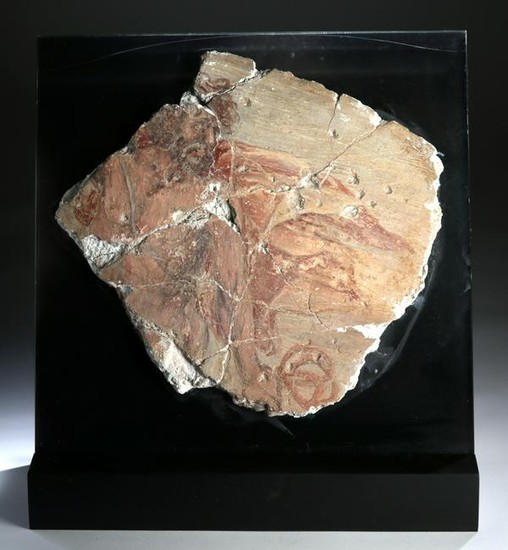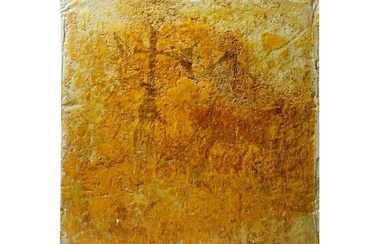Ancient Roman Fresco Fragment - Nude Male
Roman, Imperial Period, ca. 1st century CE. An ancient Roman fresco depicting a seated male with and upraised knee, nude save his cloak, the fabric of which is billowing in the direction he is facing. His profiled visage is quite naturalistically rendered with a wide open eye, long nose, bushy beard, and long wavy coiffure. Size: 10.875" W x 10.375" H (27.6 cm x 26.4 cm); 12.75" H (32.4 cm) on included custom stand.
The ancient fresco technique involved applying saturated pigments into wet lime-rich plaster, and only the wealthiest, most elite Romans adorned their houses with these elaborate wall paintings which required immense skill to create. Art historians have identified four styles of wall painting. This example aligns closest with the Second Pompeiian Style - also known as the architectural style - which was popular during the 1st century BCE. This style was characterized by illusionism whereby the walls were painted with architectural elements framing compositions that fooled the eye into believing they were real via a trompe l'oeil effects. The artist of this piece also successfully achieved naturalism in the visual imagery via subtle tonal changes, modeling the figure with color and shading, and suggesting depth with foreshortening.
Another aspect of Roman wall painting to appreciate are the brilliant colors which contrast with the white hues of surviving ancient marble sculpture. Scholars have demonstrated that classical sculptures were actually originally brightly painted; however, the pigments have worn away over the ages. Thankfully, ancient wall paintings demonstrate the bold coloration that embellished ancient visual culture. What's more while some of the most impressive artists of the Classical world were painters, sadly, many of their creations were painted on wood panels and have disappeared due to the perishable nature of this material. Thankfully, other forms of Classical art such as vase paintings, mosaics, and even a few fresco fragments like this example - many surviving from Pompeii and Herculaneum buried under the ash of a volcanic eruption in the year 79 CE - have survived the tests of time and can provide a means of understanding ancient painting techniques.
Provenance: ex-William Froelich collection; ex-private Leit collection, Los Angeles, California, USA, acquired in London and imported to the US in 1986
All items legal to buy/sell under U.S. Statute covering cultural patrimony Code 2600, CHAPTER 14, and are guaranteed to be as described or your money back.
A Certificate of Authenticity will accompany all winning bids.
We ship worldwide to most countries and handle all shipping in-house for your convenience.
#147486
Condition Report: A section from a larger fresco. Repaired from about 10 pieces with losses to the breaklines, surface chips here and there on the composition, and losses to the peripheries. There is some expected pigment loss, but enough has survived to render the image.
View it on
Sale price
Estimate
Time, Location
Auction House
Roman, Imperial Period, ca. 1st century CE. An ancient Roman fresco depicting a seated male with and upraised knee, nude save his cloak, the fabric of which is billowing in the direction he is facing. His profiled visage is quite naturalistically rendered with a wide open eye, long nose, bushy beard, and long wavy coiffure. Size: 10.875" W x 10.375" H (27.6 cm x 26.4 cm); 12.75" H (32.4 cm) on included custom stand.
The ancient fresco technique involved applying saturated pigments into wet lime-rich plaster, and only the wealthiest, most elite Romans adorned their houses with these elaborate wall paintings which required immense skill to create. Art historians have identified four styles of wall painting. This example aligns closest with the Second Pompeiian Style - also known as the architectural style - which was popular during the 1st century BCE. This style was characterized by illusionism whereby the walls were painted with architectural elements framing compositions that fooled the eye into believing they were real via a trompe l'oeil effects. The artist of this piece also successfully achieved naturalism in the visual imagery via subtle tonal changes, modeling the figure with color and shading, and suggesting depth with foreshortening.
Another aspect of Roman wall painting to appreciate are the brilliant colors which contrast with the white hues of surviving ancient marble sculpture. Scholars have demonstrated that classical sculptures were actually originally brightly painted; however, the pigments have worn away over the ages. Thankfully, ancient wall paintings demonstrate the bold coloration that embellished ancient visual culture. What's more while some of the most impressive artists of the Classical world were painters, sadly, many of their creations were painted on wood panels and have disappeared due to the perishable nature of this material. Thankfully, other forms of Classical art such as vase paintings, mosaics, and even a few fresco fragments like this example - many surviving from Pompeii and Herculaneum buried under the ash of a volcanic eruption in the year 79 CE - have survived the tests of time and can provide a means of understanding ancient painting techniques.
Provenance: ex-William Froelich collection; ex-private Leit collection, Los Angeles, California, USA, acquired in London and imported to the US in 1986
All items legal to buy/sell under U.S. Statute covering cultural patrimony Code 2600, CHAPTER 14, and are guaranteed to be as described or your money back.
A Certificate of Authenticity will accompany all winning bids.
We ship worldwide to most countries and handle all shipping in-house for your convenience.
#147486
Condition Report: A section from a larger fresco. Repaired from about 10 pieces with losses to the breaklines, surface chips here and there on the composition, and losses to the peripheries. There is some expected pigment loss, but enough has survived to render the image.




